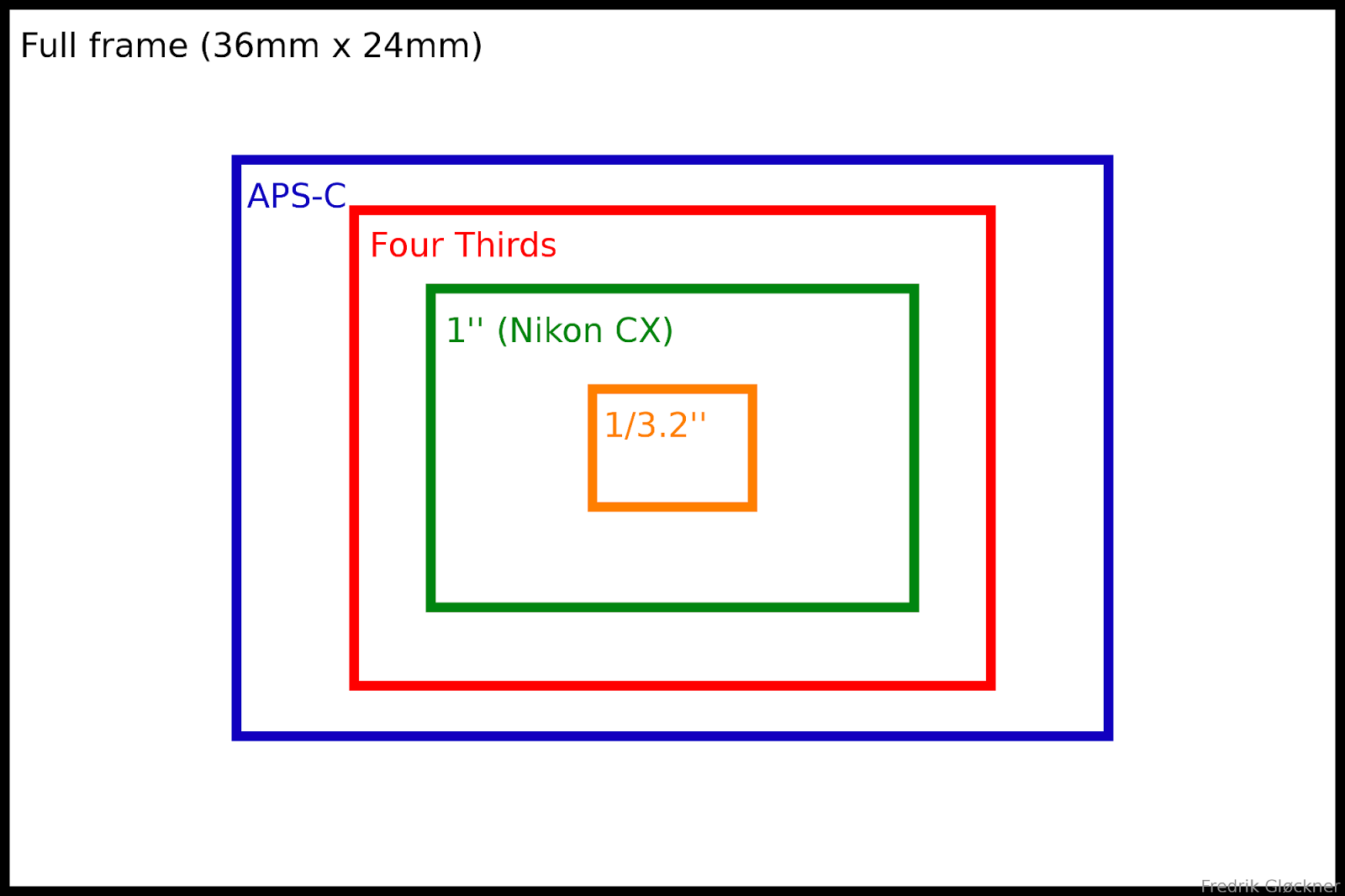Here, I am going to illustrate how the sensor size affects the degree of selective focus. Some would say "the amount of bokeh", but that is the wrong use of the term. I'll stick to the correct nomenclature in this article, to avoid angering people.
First off, here is a comparison of common sensor sizes:
The full frame sensor size is derived from the common 135 film format, commonly used in SLR and compact cameras. At this time, there is only one mirrorless camera system which uses a full frame sensor, the Sony A7 series. You'll also find full frame sensors in Nikon D810 and Canon 5D III DSLR cameras, to name a couple.
APS-C sensor size sensors are found in a vast number of DSLR and mirrorless cameras. This is pretty much the norm size for consumer system cameras. The crop factor is found by calculating the ratio of the full frame diameter (43.3mm) to the APS-C sensor diameter (28.3mm), which is 1.5.
The Four Thirds sensor size was introduced by Olympus with the E-1 DSLR camera in 2003. It has a crop factor of 2, and was later reused for Micro Four Thirds in 2008.
In 2011, Nikon launched the CX format, which uses a so-called 1 inch sensor. The sensor size is also used in the Sony RX100 camera line as well, and is becoming the norm size for premium compact cameras. The crop factor is 2.7.
Many smaller sizes of sensors are used in compact cameras, and 1/3.2'' is just one example. It is used in the Iphone. The crop factor is 7.6.
Here are some example images taken with a normal lens, using sensor crop factors from 1.5 to 7.6, and using apertures f/1.4, f/1.8 and f/2.5. The focus was set on the tree in the left foreground.
Crop factor
|
APS-C, 1.5x
|
Four Thirds, 2.0x
|
1 inch, 2.7x
|
1/3.2'', 7.6x
|
f/1.4
| ||||
f/1.8
| ||||
f/2.5
| ||||
| Camera |
Pentax K10D with Sigma 30mm f/1.4
|
To more easily compare the amount of selective focus, please see these 100% crops from the images. The Iphone picture was not entirely similar, but the point is that with the small sensor, most of the image is in focus.
What we see here, is that the larger the aperture (smaller f-stop number), the more selective focus (top row has f/1.4). Also, the larger the sensor, the more selective focus effect (left column has 1.5x crop factor).
So, does this mean that you'll always want the biggest possible sensor size? Everybody should buy Sony A7 cameras?
It depends on what you want with your images. If you want to use selective focus as an effect, then yes, the bigger sensor, the better. Personally, I don't think that a very selective focus is always preferable, so I am perfectly happy with the Micro Four Thirds and Nikon 1 camera systems.
Also, when selecting smaller sensor camera systems, you get smaller lenses and smaller cameras. Here are the systems I used for the image series above:
From left to right: Pentax K10D with Sigma 30mm f/1.4, Lumix GM1 with Leica 25mm f/1.4, Nikon 1 V3 with Nikkor 18.5mm f/1.8, and an Iphone for scale.
Generally speaking, the larger the sensor, the larger the camera and the lens. And a compact camera system is often favoured.
Conclusion
If you want to use selective focus (and bokeh) as an effect, then go for a camera system with a reasonably large sensor. However, larger sensor systems are often larger, heavier, and more costly.
If you go for a camera with a moderate sensor size, like Micro Four Thirds or Nikon 1, then you need a fairly large aperture lens to get a significant selective focus effect.
Example lenses to achieve this are, for Micro Four Thirds: Leica 42.5mm f/1.2 and Leica 15mm f/1.7. And for Nikon 1: Nikkor 32mm f/1.2.



I have found that a software solution to a sort of "Fake Bokeh" for 4/3s sensors is quite acceptable. Many editing and development software titles offer some sort of "Blur" tool. I use ACDSee Pro 8, and I've found that a light touch of the selective blur of the edit tab to areas where Bokeh is desirable to provide a very similar effect to Bokeh.
ReplyDeleteIt takes some practice to try and view your photo as a series of focal planes that have varying levels of being in focus. (To be effective and believable, you need to blur everything within the same plane of focus). But that is the only hard part, actually softening that plane is not difficult with the right set of tools, and with a tool that feathers appropriately, the softening doesn't require an exacting steady hand.
I don't use this effect all the time, but some photos really need some selective softening.
Yes, I agree with you. I'm not afraid of using some software tricks when editing the photos. Some times, fake "bokeh" may enhance the image, so why not?
DeleteIt seems now that we are in a "sensor size war" between the manufacturers. The public has become more aware of the benefits of large sensors, and are willing to pay a premium size for such cameras. For example, the Lumix LX100, Canon G7 X and Sony RX100III.
On the other hand, with the increased processing power of smart phones, I expect that "fake bokeh" apps are going to become better and easier to use.